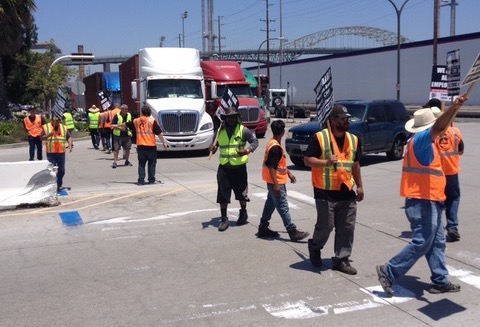ONE’s Chief Executive Officer Jeremy Nixon spoke out against what he described as inefficiencies in U.S. and North American container terminal operations, warehousing, chassis handling and a lack of 24/7 operations.
His remarks came at a time when U.S. agricultural exports are struggling to book freight on ocean carriers while other U.S. shippers are complaining of high ocean carrier rates and reliability.
Nixon was speaking to the Trans-Pacific Maritime conference in Long Beach on March 1st and answered questions from moderator Lars Jensen, Partner Vespucci Maritime.
Nixon reported there are currently about 140 ships slow steaming to North American ports and that number could increase once shipments are expedited from China following the end of Chinese New Year.
Nixon focused on the difference between Asian terminal operations and those in the United States following the COVID outbreak and the surge in imports that began flowing from Asia to U.S. ports in July 2020.
Although Nixon repeatedly referred to problems in North American operations, it was apparent in his examples that he was focusing on problems in the United States.
Nixon noted there is a huge gap in the efficiency and productivity of cargo-handling between Asia and the United States and he blames U.S. supply chain problems caused by the failure of U.S. companies to sufficiently invest in supply chain operations and rationalize this with just in time methods that did not provide a buffer for the shortages and bottlenecks that have plagued the United States since 2020.
These productivity failings created a type of domino effect that resulted in supply chain dislocations that have caused shortages in stores and price inflation.

Lack of 24/7 Operations in North America
Nixon compared container terminal productivity between the United States and Asia and highlighted the failure in North America to work on a 24/7 basis referencing the ports of Los Angeles and Long Beach:
“Asia works 24/7 so 168 hours a week and the terminals are working 24/7 and the ships are working 24/7. We come to the ports here … we took LA/Long Beach as an example, and we step down to 66% of that. So, we go down from 100% of operating hours to 66% of operating hours. So, then we get down to the terminal gates and work has been done on that recently but back then we were only getting 52% of (Asian) production.
So, then we go on to land and we have further challenges on availability of working hours in the DCs (distribution centers) and warehouses. We thought things would bounce back but North American ports don’t have the capacity that we have elsewhere in the world… So, we said a number of things have got to change but here we are a year later and we’ve still got these challenges.”
Nixon noted that in 2021 there was a surge of 16 million extra TEUs for ocean carriers to transport and “of that 16 million the surprise was that 8 million emanated from China and that unlike some projections that companies were moving out of China to Southeast Asia and other localities: That didn’t happen. The China factory actually got stronger.”
While there have been some dislocations in Asia during 2021 “it has been reasonably stable since October.”
The same was not the case in North America:
“From July/August we saw congestion get worse and worse. Things seem to be getting slightly better now but let’s look at the data in the next 6-8 weeks … There has been about a 25% growth in container capacity over the last five years. The actual effective container capacity has crashed down and is actually 20% less.”
This is due to delays offloading containers at U.S. ports and with inland operations.
Ocean Carriers Responded to U.S. Shippers
Nixon notes that ocean carriers have been responsive to U.S. shippers. When congestion problems surfaced in North America, shippers demanded help and container ships were taken off other routes in Europe and Africa and inter-Asia trades to support the North American demand.
Transloading Issues
A contributing factor that impacted agricultural exporters in 2021 was that some shippers began transloading more containers so as to reduce the supply of empty containers to the Midwest and to agricultural exporters.
Many shippers pulled back from using maritime containers due to problems with rail ramps and instead did “more of their own transloading operations. Unfortunately, this meant there were less maritime containers going into the center (of the United States) and therefore less boxes available for the export trade again. Maybe we should have been more proactive and kept our containers coming to the Midwest. But there were many issues for why that was not so straight forward.”
Ag Exporters May Face Container Shortage In 2022
In 2022, empty containers for agricultural exporters may still not be forthcoming:
“Unfortunately, the freight rates on the North American exports don’t justify us moving empty equipment from the coastal areas inland and bring back out… The head haul is Asia into North America …”
ONE is working with the railroads to make more empty containers available to exporters.
He said that it was unfair to say that capacity was moved from low-priced markets to the higher priced North American market: “that may or may not be a fair argument” but the result has now forced up prices in Africa and those trades that lost shipping.

U.S. West Coast Labor Contract Expires In 2022
A new possible problem that is U.S. generated is a possible labor slowdown at U.S. West Coast ports in 2022.
Nixon said that on top of the supply challenges, there is the West Coast labor situation. The International Longshore and Warehouse Union (ILWU) contract with the Pacific Maritime Association covering labor for U.S. West Coast ports will soon expire. Nixon worries that a slowdown or a strike could cripple U.S. supply chain operations and doom any hope of supply chain recovery in 2022: “The last thing we want is a human-made roadblock in the road … We can already see quite a switchover to the East Coast (from West Coast ports) and unfortunately the East Coast is about to jam up.”
The result is that “2022 for the Trans-Pacific is still a lot of red lights flashing.”
Inland U.S. Challenges: Chassis Handling
In October, the threat by the Ports of Los Angeles and Long Beach to impose fees on containers left too long on container terminals helped move containers off the terminals, however, this did not solve the problem:
“Normally the ship would have 6 gangs and normally be alongside 5 days, discharge quickly into the stacks and then backload these empties and full containers. Unfortunately, due to some of the labor shortage situations we don’t always get the six gangs we get the five gangs or four…but because the yard is so congested the terminals (provide) only two or three gangs because they can’t find the places to put the boxes. That’s the first bottleneck problem we face.”
These problems are not exclusively the fault of the terminals:
“We have a shortage of truck power. We have a shortage of chassis. But also, the warehousing operations in North America are struggling to get anything close to 24/7 operations and to free up a lot of those chassis.”
The chassis problem is a fundamental flaw in the supply chain operations of U.S. and North American companies, he says.
Elsewhere in Europe and Asia: “We don’t leave containers on chassis. The trucker comes in it’s a 2-4 hour operation. The container gets devanned. The trucker leaves the chassis or picks up another chassis and comes back with another load in 6 hours’ time and picks up the original chassis. Or they ground the box using a top lift.”
However, this does not happen in the United States or North America: “In North America that rarely happens. The container sits on a chassis and traditionally for 5-6 days. We have seen those dwell times go up to 8-12 days and in some cases over 30 days … The problem is that it soaks up that chassis fleet.”
The flaw is a reflection of poor management practices where supply chain problems need to be taken more seriously. Executives have been slow to realize that while it may make require 2,500 parts to build a car, it only takes one missing part to prevent the car being built, he said.
The reality of this supply chain truism is now beginning to dawn on U.S. executives and companies: supply chain issues need to be a top priority.
Some Sailings Will Be Permanently Cutback
Looking to the future, Nixon is predicting the carriers will cut back on services to reduce their exposure to future traffic jams at ports and will focus their sailings on the more profitable trades.
One example and more bad news for agricultural exporters is cutbacks to service at the Port of Oakland. Nixon said ONE had cutback seven sailings to Oakland and plans to restore some but not all of these sailings.
Other smaller ports are likely to experience similar service reductions.

